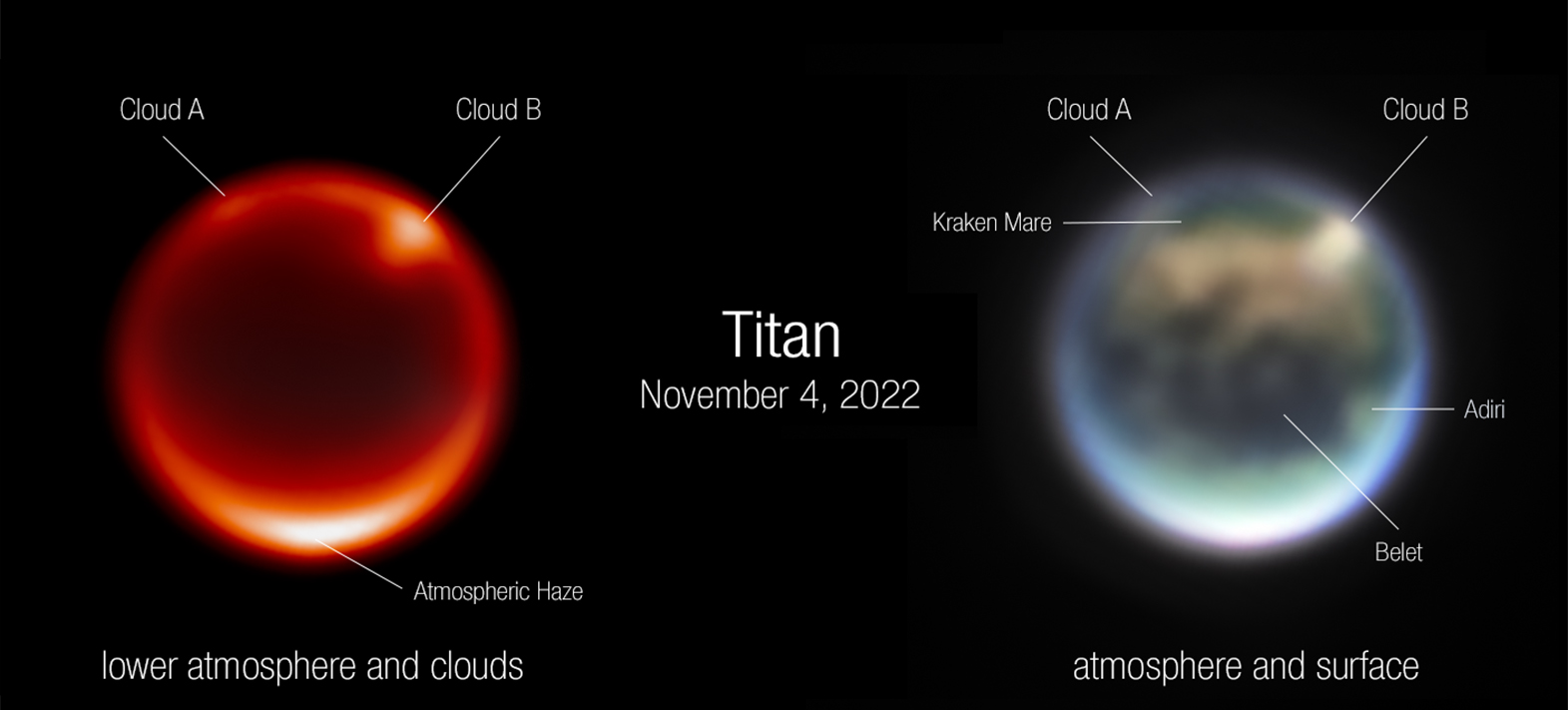First observations of Titan by the James Webb Space Telescope
On November 4, the James Webb Space Telescope, of the American (NASA), European (ESA) and Canadian (CSA) space agencies, pointed its instruments at Titan, Saturn's largest satellite. These observations were the subject of a press release on December 1 by the American and European agencies. Sébastien Rodriguez, lecturer at Université Paris Cité, and Maël Es-Sayeh, PhD student in the Planetology and Space Sciences team of IPGP, both members of the international team that pilots and analyzes these observations, come back on these new images and what they bring to the study of Titan.

– Why is this natural satellite of Saturn of such interest to scientists?
Sébastien Rodriguez: ” Titan is the only moon in the solar system with a dense atmosphere, and it is also the only planetary body other than Earth that currently has active geological and climatic activity, with rivers, lakes and seas. However, the liquid on Titan’s surface is composed of hydrocarbons, including methane and ethane, not water, as on Earth. But its atmosphere, surrounded by a thick haze of complex organic compounds, is opaque in most visible and near-infrared wavelengths, except for a few atmospheric transmission windows where the surface can be distinguished. “
– Why use a space telescope to study Titan?
S. R.: ” Titan was intensively studied during the international Cassini-Huygens mission (link) between 2004 and 2017 and will be the target of NASA’s Dragonfly mission (link) from 2035. In the meantime, for about 20 years, our only opportunities to continue to follow the evolution of Titan’s complex climatic and geological systems are to use the most powerful ground-based telescopes (e.g. VLT, Gemini and Keck telescopes) on the one hand, and on the other hand, the James Webb Space Telescope (JWST), space-based since December 2021 and operational since early summer 2022, with unparalleled sensitivity, spectral coverage and accuracy. ”
Maël Es-Sayeh: ” Solar system observation is one of the four major observing missions of JWST, along with exoplanets, the Milky Way and extragalactic. Titan is one of the prime targets of the solar system observation programme, and observations of Saturn’s moon have been scheduled since the first JWST lights. The latest observations were made on 4 November and are part of the Guaranteed Time Observations (GTO) programme. Our group of French scientists from IPGP, Université Paris Cité, CNRS, and several laboratories (LESIA, LPG Nantes, GSMA) is part of the international team that is piloting and analysing these first observations. Given the time needed to plan and validate the observations, the wait for the confirmation of the launch date of JWST and the confirmation of its perfect functioning, these observations have been expected for many years! Further JWST observations will complete them in spring 2023. Over the next decade, it is also planned to offer regular campaigns of observations from ground-based telescopes and JWST. “
– What should the analysis of these images add to our knowledge of Titan?
S. A.: ” The observations of Titan on the night of 4-5 November 2022 were made by the JWST Near Infrared Camera (NIRCam) and Near Infrared Spectrograph (NIRSpec) instruments. These two instruments allow a wide spectral coverage (from 0.7 to 5.3 µm wavelength), with a spatial resolution worthy of the largest ground-based telescopes (nearly 200 km) and an unprecedented sensitivity. The NIRSpec instrument also provides access to a much better spectral resolution than that available with the Cassini-Huygens mission and a much wider wavelength coverage than with ground-based telescopes. While waiting for Dragonfly, these observations give us access to an extremely fine analysis and understanding of the complexity of Titan’s atmosphere and surface, both in terms of composition and dynamics and activity. ”
M. E.-S.: ” In the NIRCam images (Figure above), a preliminary analysis allows us to distinguish methane clouds in the northern hemisphere. With the help of these same images, in different wavelengths, we can also recognise a number of geological structures (dune fields, hydrocarbon seas). The spectral images obtained with the NIRSpec instrument give us access to a whole new set of information on the fine composition of Titan’s atmosphere and surface (Figure below).
All these new observations, which are currently being analysed in depth and will soon be published in scientific journals, already give us a much better understanding of Titan’s meteorological and geological activity and its changes with the seasons, over long periods of time (one season on Titan lasts 7 years!). These observations are fundamental to complement the past observations of the Cassini-Huygens mission and the regular monitoring from ground-based telescopes.







